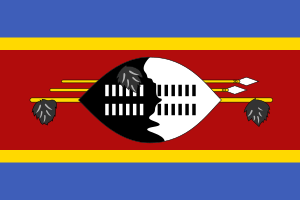Flag of Eswatini facts for kids
The flag of Eswatini is a special symbol for the country. It was officially chosen on October 6, 1968. This was the same year Eswatini became an independent nation. The flag shows important parts of Eswatini's history and culture.
Contents
What the Flag Looks Like
The flag of Eswatini has several horizontal stripes and a central design.
- At the top and bottom, there are two thin blue stripes.
- Inside these, there are two thin yellow stripes.
- In the middle, there is a wide red stripe. This red stripe is much wider than the others.
The Symbols in the Middle
Right in the center of the red stripe, you'll see a large black and white Nguni shield. This shield is a traditional item used by the Swazi people. Behind the shield, there are two spears and a staff. The staff is decorated with special feather tassels. These tassels are called injobo. They are made from the feathers of birds like the widowbird and the lourie.
What the Colors and Symbols Mean
Every part of the Eswatini flag has a special meaning. These meanings tell a story about the country and its people.
The Colors
- Blue: The blue stripes on the flag stand for peace and stability. They represent the clear sky over Eswatini and the hope for a peaceful future.
- Yellow: The yellow stripes represent the rich natural resources of Eswatini. This includes the country's mineral wealth and other valuable things found in the land.
- Red: The wide red stripe symbolizes the past struggles and battles fought by the Swazi people. It reminds everyone of the courage and bravery shown in defending their country.
The Central Symbols
- The Nguni Shield: This black and white shield is a strong symbol of protection. It shows that Eswatini is ready to defend its land and its people. The black and white colors on the shield also represent people of different skin colors living together in peace.
- The Spears and Staff: The two spears and the staff behind the shield represent defense and authority. They show the country's ability to protect itself from any threats. The staff with the injobo (feather tassels) is a symbol of the monarchy and traditional leadership in Eswatini.
History of the Flag
The flag was designed to celebrate Eswatini's independence from British rule. It was first used on October 6, 1968. The design was chosen to reflect the nation's identity and its journey to becoming a free country. It combines traditional Swazi symbols with colors that represent important national values.
Images for kids
-
Commonwealth Day, 2014, London: Swazi flag on the extreme left
See also
 In Spanish: Bandera de Suazilandia para niños
In Spanish: Bandera de Suazilandia para niños



